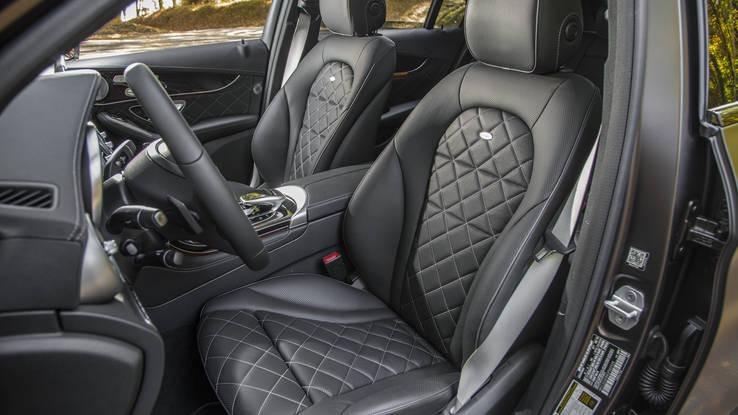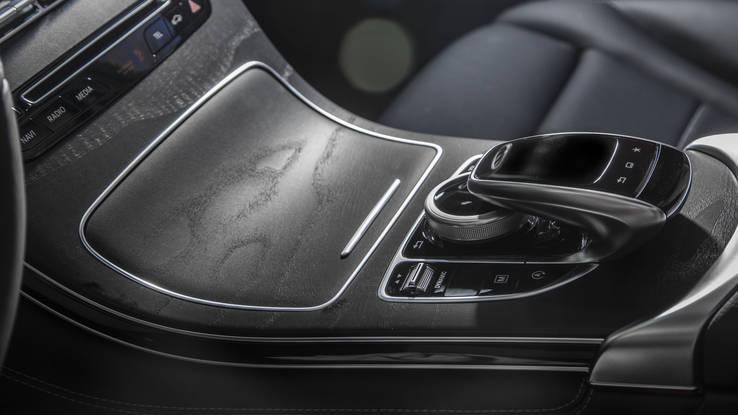Redesigned for 2016, Mercedes GLK replacement gets C-class refinements
What is it?
Essentially, the 2016 Mercedes GLC is a simple evolution of the outgoing GLK. Not as simply, this is an off-road capable C-class luxe-people hauler. The GLK did reasonably well in the small-luxury SUV department, but one fairly common complaint was that it was too small – especially in the cargo area. In revising the platform, Mercedes pulled and stretched this SUV in every direction: it’s two-inches wider in total width, gains 4.6-inches in total length and has 0.3-inches more headroom.
To match the stretched shell, the wheelbase also gains 3.6-inches, and the track width front/rear tacks on a respective 1.9-inch/0.8-inch bump. All those numbers boil down to a bigger, wider and more stable-feeling ‘ute than its predecessor.

Mercedes dropped the six-cylinder, and the only available engine is the turbocharged I4.
In pursuit of lower emissions, the V6 from the GLK has been dropped in lieu of a turbocharged I4. Not that it’s in bad company: the Audi Q5, Lincoln MKC, Lexus NX, and Range Rover Evoques have already received the same treatment. The four-cylinder in the GLC is shared with the C-Class, and produces healthy power: 241 hp at 5500 rpm to be exact, plus a very usable 274 lb-ft of torque at 1300 rpm. It also will ride a flat torque curve all the way through 4000 rpm.
Carrying over more than just suspension ideas and powertrain from the C-Class, the GLC 300 receives touches of style from its sedan sibling. Subtle creases underneath the beltline and a grille that looks like it could interchange with the C-Class, show the family resemblance – the sloping roofline and more fluid tailgate set the styling apart from the boxy GLK. Despite its sleeker and more elegant appearance, there’s no sacrifice in cabin space. Leg room and headroom in the rear seats are both abundant – in fact, the rear is spacious enough to fit three full-grown adults…comfortably. Even with the optional panoramic roof, headroom should not be an issue for those of taller statures.
The standard interior lives up to the Mercedes-Benz badging, but feels like it belongs in a sub-$ 40k SUV. Which is fine, because that’s exactly what the GLC is – however, the designo interiors are available for those who need luxury in droves, and for a mere $ 1,450 the upgrades are almost a bargain.

On the other hand, the optional designo interiors are kind of worth the money. They feature quilted leather inserts on the seats and door panels, and can be combined with heated rear seats — matching the standard front heated seats.
How does it drive?
The 241 hp from the new engine provides pleasant, linear acceleration, which is what you’d expect from Mercedes-Benz, but won’t impress an X3 35i driver. The new 9G-Tronic nine-speed transmission helps keep the RPMs down, keeping you inside that torque curve. The 0-60 time is around 7.45 seconds in sport-plus mode; not bad, considering the heft that this I4 hauls: The GLC’s curb weight is almost 3,900 lbs with rear-wheel drive. The all-wheel drive 4-matic system tacks on another 120 pounds, but it’s not too noticeable.
In fact, the all-wheel drive system doesn’t seem to affect the driving experience negatively at all. The steering feels the same between both models, and the suspension reacts just about the same.
Driving characteristics depend heavily on what driving mode you select, but the hardware is an improvement over the GLK. The addition of aluminum parts throughout the vehicle, as well as going from an independent three-link suspension to an individual four-link suspension, helps with comfort and articulation of the wheels.
Dynamic Select, as Mercedes-Benz calls it, adjusts the steering, shift points and throttle response on GLC models with steel springs, and it also sets the ride response on the Air Body Control-equipped models. The five modes of operation are: eco, comfort, sport, sport-plus, and individual. The individual setting allows the driver to select the preferred characteristics from each of the modes. Going through the different driving modes brought to light what Mercedes calls Agility Control. This feature alters the handling characteristics of the car based on what driving mode you’ve selected – a handy feature

Compared the outgoing GLK, this Cardinal Red GLC is one sleek machine.
The eco and comfort modes feel extremely similar – the steering is light and the engine isn’t bouncing off of the rev limiter. Instead, the 2.0-liter stays unobtrusive, and the 9-speed keeps the RPMs down low. We can’t attest to the efficiency of eco mode because we didn’t need to fill the cars up, but Mercedes says it helps.
Sport mode tightens the steering up a bit, and lets the engine wind out a little more. Shifts become more firm and precise. Blasting around corners in sport mode will almost make you forget you’re in a two-ton luxury SUV…almost. The steel springs provide a comfortable ride without too much roll, but given the nature of the vehicle – there will be roll. The nose also dives a bit on braking, but not enough to upset the driver. Our testers were all steel-sprung early production models, but we’ll bring you a write-up of the GLC 300 with Air Body Control soon.
The Sport plus mode even further stiffens the steering, and basically throws shift points out the window, making every shift happen at the top of the tachometer. While a maybe handy feature on the C63 AMG, it feels unnecessary on the GLC 300. The performance gain feels negligible over sport mode, and it surely will cost you some fuel economy.

Maneuvering the infotainment system is more complicated than it really should be, thanks to this controller. It may look like its fresh off the Starship Enterprise, but it feels outdated.
The semi-autonomous experience of the optional safety-tech offered on the GLC 300 is actually pretty capable. The system isn’t overly invasive like some we’ve seen from other manufacturers, but it is allegedly capable of rolling out of corners. It does frown on you when you remove your hands from the wheel for an extended period of time – so don’t do that. The Brake Assist Plus will take you help manage your malaise while stuck in traffic – helping you in stop and go situations.
The infotainment system isn’t touch screen – but looks like it should be. Visually jarring, the floating screen looks like someone at Mercedes forgot to build one into the dash, and had a spare iPad handy. What it lacks in the looks department, it makes up for it in being…freaking big. Not Tesla big, but its 7.0-inches give it visual weight. The controls for the system are a dial, and buttons, on the center console; it’s fairly intuitive, but there is a mild learning curve to use the optional navigation.

Nothing is perfect. The infotainment system looks completely like an afterthought, and someone in the Mercedes had to sacrifice an iPad. The sacrificed iPad does not have touchscreen enabled.
Do I want it?
The Mercedes GLC 300 comes into a white-hot compact SUV market against some heavy hitters. The BMW X3 and Lexus NX have both been outselling the aging GLK for a while, but this new model should impress Mercedes intenders looking for a more luxurious entry-level SUV. However, the X3 will keep its I6 for 2016, so if you’re looking for a more potent, driver-focused candidate the BMW is about the last of its kind. There are rumblings of a hybrid GLC as well as diesel powered model in the future, which should interest green-leaning buyers
The advertised price of $ 39,875 for the base GLC rear-drive model is well in line with competitors like the X3, and offers a lot of trucklet for the money. The problem with the GLC300, as with all German luxury models, is that base models will probably be scarce and it isn’t hard to option one of these well over $ 50K.





























